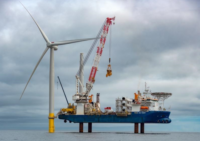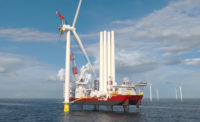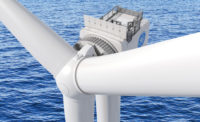Spanish-German wind engineering company Siemens Gamesa has pulled the plug on its planned $200-million plant to finish offshore wind turbine blade manufacturing, citing inability to meet unspecified “development milestones.”
The plant in the Portsmouth, Va., Marine Terminal was set to initially support a 2.6-GW offshore wind project proposed by power company Dominion Energy. It also could possibly have spurred a regional hub.
The decision was made due to “development challenges” that were unanticipated in 2021 when the facility was first announced, according to company sources, with uncertainty in the US offshore wind market propelled by unforeseen increases in construction material costs and inflation.
A Siemens Gamesa spokesman said the manufacturer “will continue to meet our obligations” for Dominion's $9.8 billion Coastal Virginia Offshore Wind project, which will involve manufacture of blades, nacelles and hubs for about 176 turbines in Europe.
Dominion says its project is “on schedule” to begin construction 27 miles offshore Virginia Beach in 2024.
“We have confidence in Siemens Gamesa, a turbine vendor with decades of experience as the global leader in wind turbine technology,” said a Dominion spokesman. He said components it made for a smaller pilot plant operating since 2020 off Virginia Beach “are exceeding expectations.” Production was contracted before inflation and supply chain cost impacts began.
'Full Steam Ahead'
“The offshore wind supply chain in the U.S. is in the development stages,” the Dominion spokesman noted. “We have that tangible evidence that offshore wind is happening in Virginia, and we are moving forward full steam ahead" to start offshore construction next May for its larger project.
The Siemens Gamesa spokesman did not confirm status of procurements for engineering or construction services for the canceled facility, nor media reports that the firm will exit its contract under a termination agreement.
Announced in October 2021, the plant was to be located on more than 80 acres at the Portsmouth Marine Terminal leased from the Virginia Port Authority. The site was adjacent to 72 acres leased by Dominion for staging and preassembly of foundations and turbines for its project. Skanska USA was awarded a $223-million contract to redevelop that site for the Dominion project and others, which included improving 1,500 ft of an existing 3,540-ft wharf.
Port Authority spokesperson Joe Harris told ENR it learned of the Siemens Gamesa cancellation in late September. As for reuse of the project site, he said the agency is “considering our options for the future.”
A private development consortium led by The Miller Group of Virginia Beach broke ground in June on a $100-million project to transform a nearby 111-are site into a maritime operations and logistics center to support offshore wind projects, as well as regional defense and transportation industries. Located along the Elizabeth River across from the Portsmouth terminal, the project will include a 7.5-acre wind energy monitoring and coordination center that is expected to be ready in 2025.
Miller Group CEO Jerry Miller told ENR that he did not expect the Siemens Gamesa cancellation to have any effect on the development, which recently received a $39.2-million U.S. Maritime Administration grant to assist in renovating site waterfront infrastructure.
Stabilizing Cash Flow
But the Siemens Gamesa cancellation comes amid reports of financial and technical issues at the company, which was formed in 2016. In June, parent company Siemens Energy announced that an increase in onshore wind turbine component failures had spurred a technical review of the unit's installed fleet and product designs. Facing losses ranging into the billions of euros, Siemens Energy was reportedly “looking at all options” to stabilize the financial drain.
Speculation in recent months of German government aid for Siemens Energy, a major energy sector participant in that country and globally, became reality on Nov. 14 when public officials said the company will gain about $16.25 billion in guarantees from the government, banks and its former parent Siemens AG. The energy unit, which was spun off as a separate public firm in 2020, said in August that the Siemens Gamesa project issues would be a factor in the $4.8-billion full year loss it expects to announce on Nov. 15.
The unit spokesman also did not confirm the development status of an estimated $500-million nacelle manufacturing plant it announced in February at the Port of Coeyman’s near Albany, as well as component supplier facilities, including those for bearings, composite parts and steel component fabrication.
That investment will likely remain unclear as offshore wind developers in New York, Orsted and BP-Equinor, weigh options for projects already underway after a state regulators’ decision last month not to allow them to raise their agreed-to project power production payments due to the elevated building costs.
“These projects must be financially sustainable to proceed," said Molly Morris, president of Equinor Renewables Americas, in a statement. "Equinor and BP will assess the impact of the state’s decision on [them]."
Sector Projects Moving
New York Gov. Kathy Hochul announced conditional contracts earlier this month with other developers to add about 4 GW of offshore wind in its round 3, which would be bid at higher prices. The new awards for projects under development by France's TotalEnergies, Germany-based RWE, U.K.-based National Grid and Denmark's Copenhagen Infrastructure Partners are still under negotiation, the state said.
The state also is investing $300 million in component plants in the Albany area to be developed by U.S. manufactuer GE and LM Wind Power Blades USA for nacelle and blade manufacturing and assembly.
“We know the industry is ready for a reset,” GE CEO Larry Culp said on a recent corporate results call with analysts, noting that its offshore wind division is expected to lose $1 billion this year. “We think we can make a much better business with offshore wind, but we’re staring at some challenges that we need to address here in the fourth quarter and in 2024."
GE has said it will spin off next year its energy business, including offshore wind, into a new company called GE Vernova.
But the Virginia cancellation also follows the decision last month by developer Orsted to cancel its two large offshore wind projects in New Jersey that were set to generate up to 2.25 GW.
Land-based supporting production at the New Jersey Wind Port, a turbine assembly facility, now is set to slow construction of its first phase until mid-2024 “to derive savings through avoided acceleration,” Jonathan Kennedy, New Jersey Economic Development Authority vice president for infrastructure and project managing director, told industry publication Recharge.
The 1.5-GW Atlantic Shores project remains in development by a Shell-EDF joint venture, which has committed to leasing manufacturing and assembly space at the Wind Port by 2026, said Kennedy, who hopes to also gain users from other east coast projects from 2024 to 2026. When both phases of the port are completed in 2026, it will cover over 200 acres.





